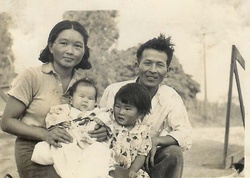The on-shore winds have danced all night up and down over Rose Hills. They have then come down full speed, however humble, and with their innards laden with ocean moisture; now they are crawling eastward, along Puente Avenue. By six and even seven AM, the dew is gratefully absorbed by the unnatural vegetation that the residents have forced on this arid bend of California’s soil.
In one of your early morning runs or walks, deliberately stop for a moment in front of the East San Gabriel Valley Japanese Community Center in West Covina, CA. Notice the wide expanse of land in front of the building, one side adorned with Black Pines and the other with a clump of tall junipers. Now advance towards the pines west of the Social Hall. There is little or no lawn to gripe at your presence. The dew bedecks the trees’ needles as if ready to celebrate a daily Christmas. And you could swear that, in their nightly labors, the spiders meant to hang a diamond curtain between branch and branch.
Pines like these are natural treasures. Japan reveres them for their beauty, and their ability to attract the good spirits. Shaping these trees under constant care produces what dazzles your eyes: branches bent in daring shapes, exquisitely free from excessive shoots, and gnarled trunks set to outlast twenty-four of your own generations. For a Black Pine (Pinus Thunbergiana), one hundred years is but a small chapter in their history. Black Pines over 800 years old are quite common in our beloved Japan.
Such is the bequest that Frank Yamashita, by himself, over fifty years ago created for our pleasure. He took some true Japanese Black Pine saplings into his home, and patiently cultivated and shaped them constantly. His secret was lots of loving hours spent in forming them into his desired shapes. He gently culled every imperfect sprout, and coaxed the surviving growth to acquire a graceful form, through a system of string and wire binding that shaped them into royal specimens.
Shortly after the Center was acquired in the 1950s, he planned its landscape. Inch by inch, he cultivated the land to free it from extra vegetation, and to insure that the trees would get all the nutrients they needed for survival. Then he set the trees in place, as Imperial Princes guarding their new home. And he did it all by himself.
In that effort he also created a miracle. Japanese Black Pines thrive in coastal areas, particularly in the heights surrounding the ocean, where the trees are bathed by sunshine, cool winds, and constant humidity. But this area, their new habitat, is a dry valley at least twelve degrees hotter than Seal Beach, some 32 miles south. The task of “Hair Dressing,” lovingly pruning, and delicately shaping, was at first provided every spring by Frank, himself, and then adopted by the experienced “Pine Trimming Group” formed with members of different Japanese American organizations.
I asked Kim Hatakeyama, one of our beloved patriarchs, and one of the founders of the Gardeners Association.
“Did you help Frank, or did he do that by himself?”
“I don’t remember if I did, said Frank. All I know is that I stood there, gazing in wonder. I was a young green-horn trying to learn landscaping, and here was a Master, showing us how to do our best.”
The question arose about what to do with these Monarchs of Nature, as we execute the Social Hall reconstruction plan. Among the suggestions offered, blasphemy arose naturally: “Cut them out, and when the project is finished, plant new trees.” You cannot just kill Imperial Natural Treasures and hope to find somewhere, somehow in the uncertain future another royal scion willing to be trimmed and trained. Trees of the quality and shape as those you see here are extremely difficult to raise. Only the genius of a man like Frank Yamashita could create the miracle…Once! Royalty like this can easily command a price of $10,000 or more, per tree, as the most formidable asset in a deluxe garden somewhere in a hi-tone neighborhood.
After months of research, expert consultation, and deep pondering, it was decided to “box” the trees and set them at the back of the parking lot, waiting for the completion of the project. The first conservation face, “boxing,”—setting a strong wooden crate in the soil around them, has already begun. Next, sometime in mid-year and considering when the optimal climatic conditions occur, it will be raising them, building the bottom of the box, and moving them from the ground to the back portion of the parking lot. Ultimately, when the project was completed, the frontal landscape was re-planned, and it is now an exquisite miniature Japanese garden, the pride of West Covina.
I can only bless Frank’s spirit, millions and millions of times for his generosity in giving us the treasure of his genius and his love of Nature. Were it in my power, I would count him and his trees among the National Treasures of both our country and Japan, for he always represented for me both the ancient Yamato Spirit and the daring and creativity of the New American. Very few organizations are as lucky as ours in having had him as a founder. His bequest to us merits our most grateful handling of it.
* This article was originally published in the East San Gabriel Valley Japanese Community Center’s “Newsette” in February 2008.
© 2008 Edward Moreno






